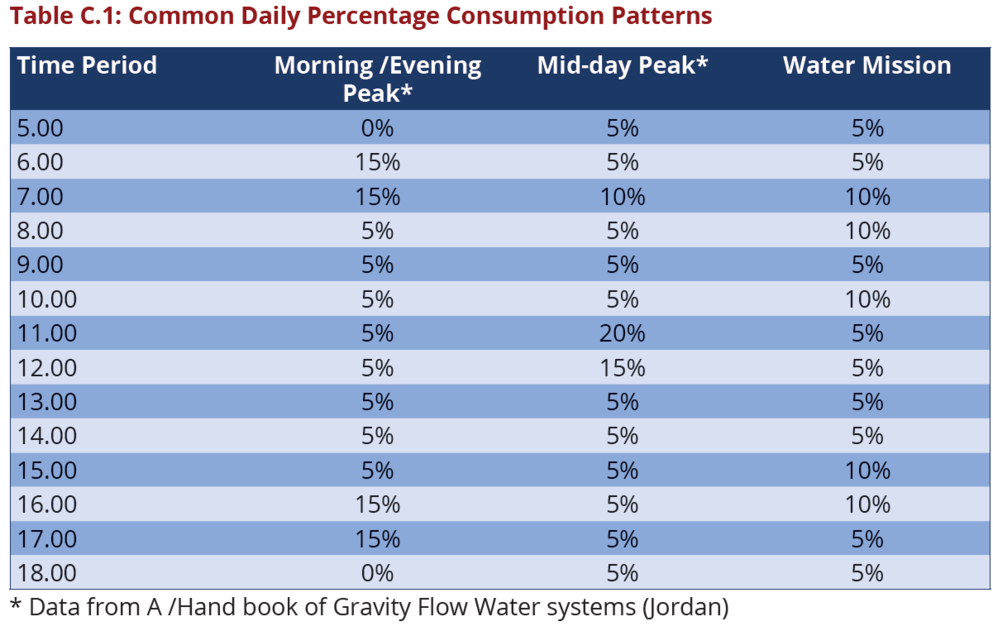Difference between revisions of "DCOM Volume I Appendix C"
| Line 1: | Line 1: | ||
| − | = | + | = APPENDIX C: EXAMPLE ON ESTIMATING THE CAPACITY OF A STORAGE TANK = |
| − | Estimate the minimum storage tank capacity for a solar powered system assuming 40L/Min for 6.5 hours per day, a daily water demand of 15,000L and the, morning evening peak pattern from shown on table below: | + | Estimate the minimum storage tank capacity for a solar powered system assuming |
| + | 40L/Min for 6.5 hours per day, a daily water demand of 15,000L and the, morning | ||
| + | evening peak pattern from shown on table below: | ||
| − | + | [[Image:AppendixcTableC.1.PNG|993px|link=DCOM_Volume_I]] | |
| − | |||
| − | |||
| − | |||
| − | |||
| − | |||
| − | |||
| − | |||
| − | |||
| − | |||
| − | |||
| − | |||
| − | |||
| − | |||
| − | |||
| − | |||
| − | |||
| − | |||
| − | |||
| − | |||
| − | |||
| − | |||
| − | |||
| − | |||
| − | |||
| − | |||
| − | |||
| − | |||
| − | |||
| − | |||
| − | |||
| − | |||
| − | |||
'''Step 1: Determine the daily water demand pattern'''<br> | '''Step 1: Determine the daily water demand pattern'''<br> | ||
| + | The first step is to determine how much water will be used at different times | ||
| + | during the day in a specific community. This can be accomplished by observing | ||
| + | the community water collection habits. Water Demand for each time period can | ||
| + | be calculated based on percentages obtained in the community water collecting | ||
| + | habits. The balance is determined by subtracting the demand from the supply | ||
| + | and adding it to the current surplus/deficiency balance. | ||
| − | + | [[Image:AppendixcTableC.2.PNG|993px|link=DCOM_Volume_I]] | |
| − | + | '''Step 2: Determine the minimum tank capacity'''<br> | |
| − | + | To ensure sufficient water to a community, there must be enough water to last | |
| − | + | until the trough of the next day. This calculation is represented as;<br> | |
| − | + | V<sub>tank</sub> = V<sub>max</sub> – V<sub>min</sub> – V<sub>final</sub> <br> | |
| − | + | V<sub>tank</sub> = 4,500L – (–5,400L) – 600L = 9,300L <br> | |
| − | |||
| − | |||
| − | |||
| − | |||
| − | |||
| − | |||
| − | |||
| − | |||
| − | |||
| − | |||
| − | |||
| − | |||
| − | |||
| − | |||
| − | |||
| − | |||
| − | |||
| − | |||
| − | |||
| − | |||
| − | |||
| − | |||
| − | |||
| − | |||
| − | |||
| − | |||
| − | |||
| − | |||
| − | + | The water storage tanks should be able to hold at least 9,300 L to suffice the need | |
| − | + | of the community. The designer should use 10,000 L storage tanks or use two | |
| − | + | 5,000 L storage tanks in sizing of the needed capacity. | |
| − | |||
| − | |||
| − | |||
| − | The water storage | ||
Revision as of 13:31, 30 May 2021
APPENDIX C: EXAMPLE ON ESTIMATING THE CAPACITY OF A STORAGE TANK
Estimate the minimum storage tank capacity for a solar powered system assuming 40L/Min for 6.5 hours per day, a daily water demand of 15,000L and the, morning evening peak pattern from shown on table below:
Step 1: Determine the daily water demand pattern
The first step is to determine how much water will be used at different times
during the day in a specific community. This can be accomplished by observing
the community water collection habits. Water Demand for each time period can
be calculated based on percentages obtained in the community water collecting
habits. The balance is determined by subtracting the demand from the supply
and adding it to the current surplus/deficiency balance.
Step 2: Determine the minimum tank capacity
To ensure sufficient water to a community, there must be enough water to last
until the trough of the next day. This calculation is represented as;
Vtank = Vmax – Vmin – Vfinal
Vtank = 4,500L – (–5,400L) – 600L = 9,300L
The water storage tanks should be able to hold at least 9,300 L to suffice the need of the community. The designer should use 10,000 L storage tanks or use two 5,000 L storage tanks in sizing of the needed capacity.

